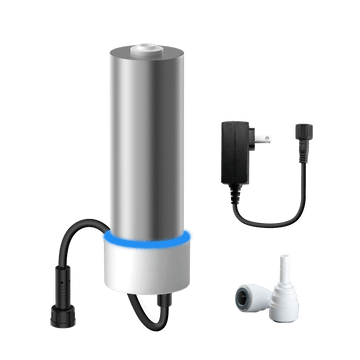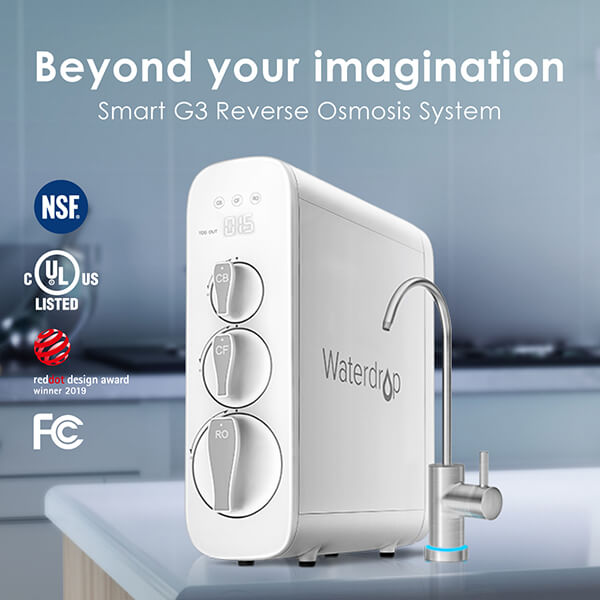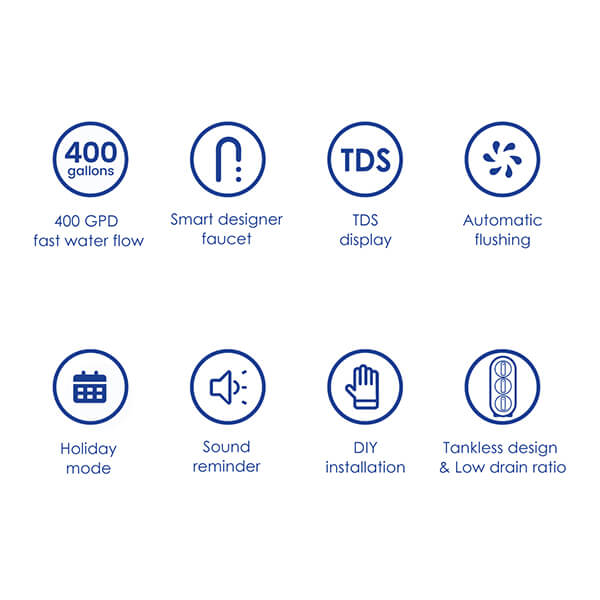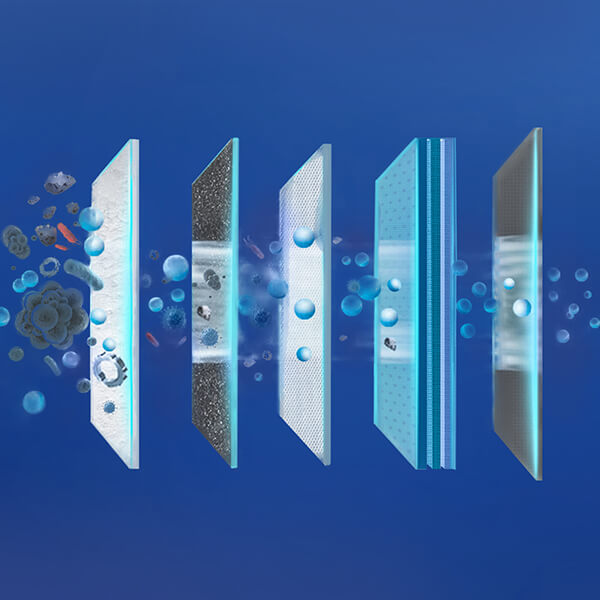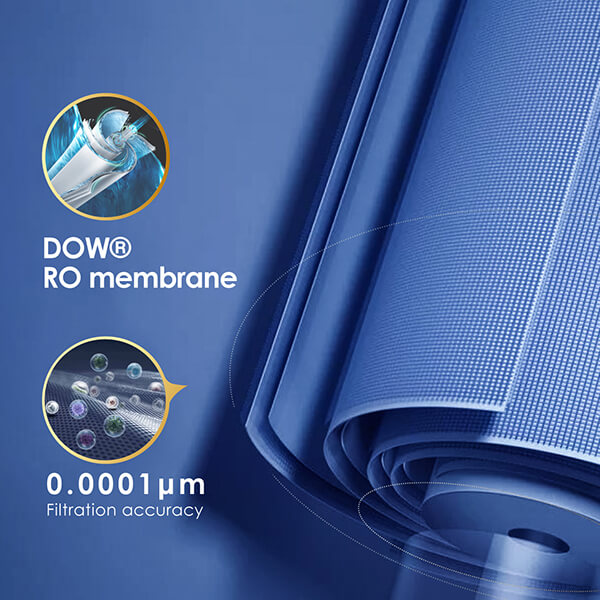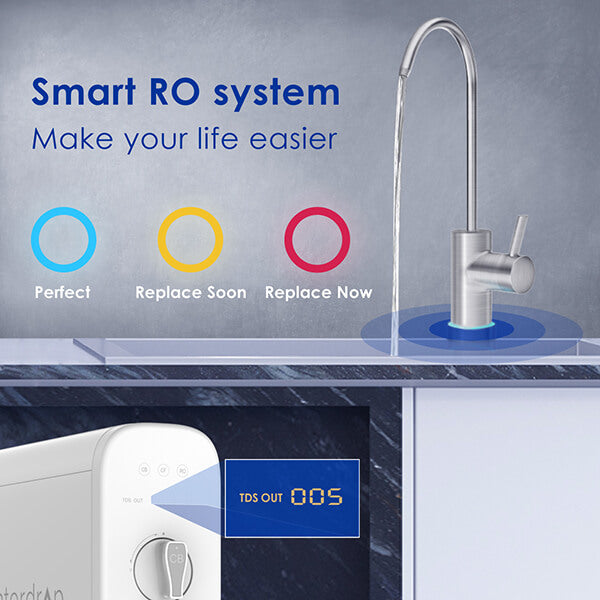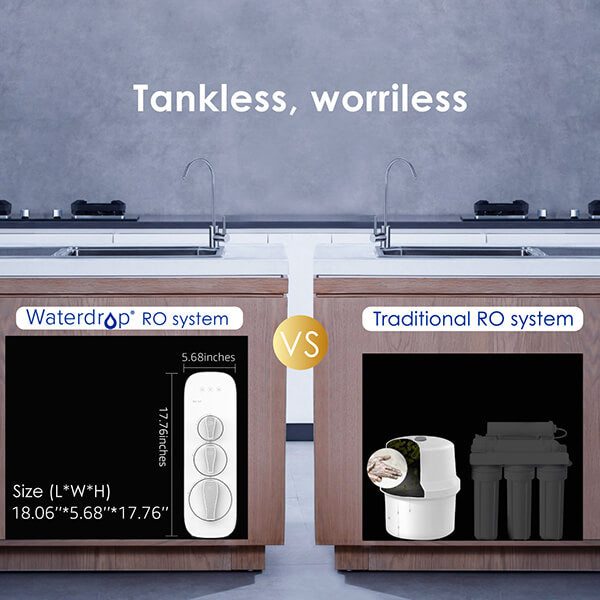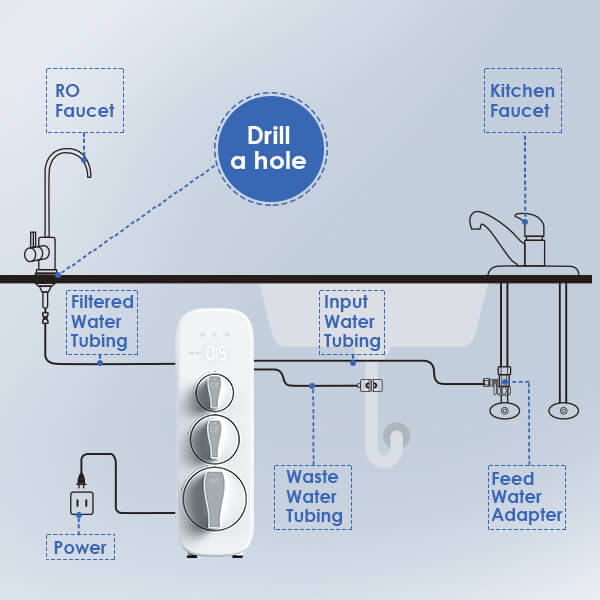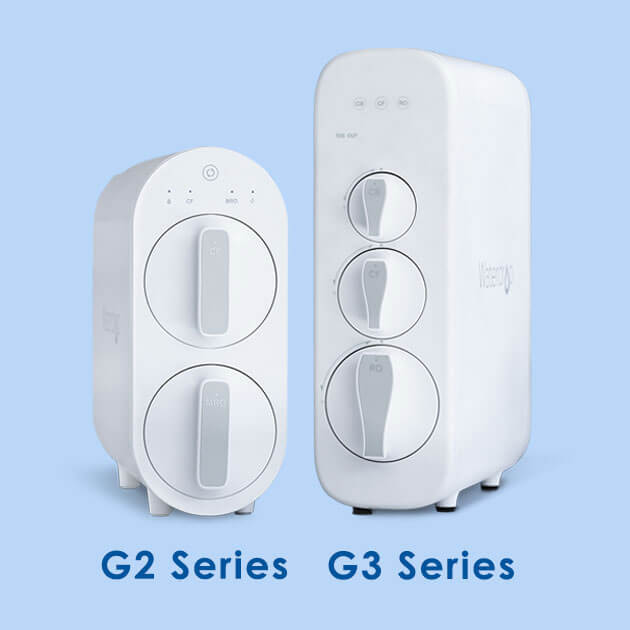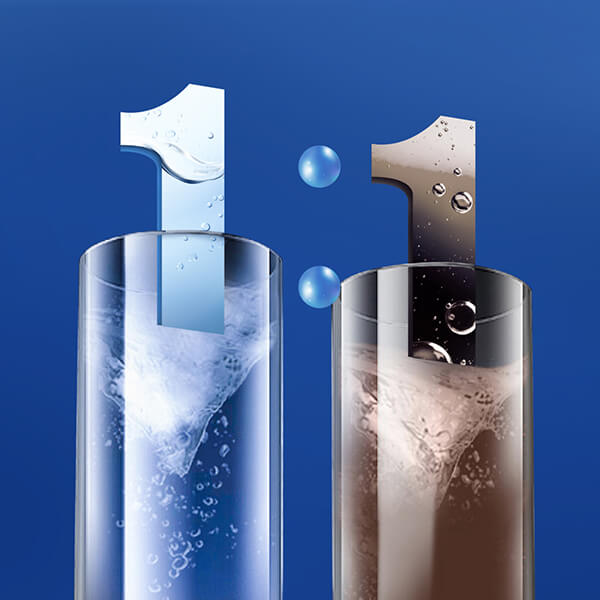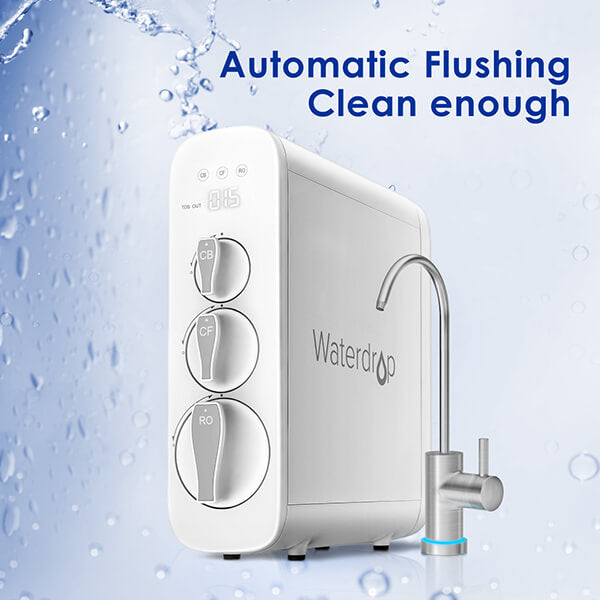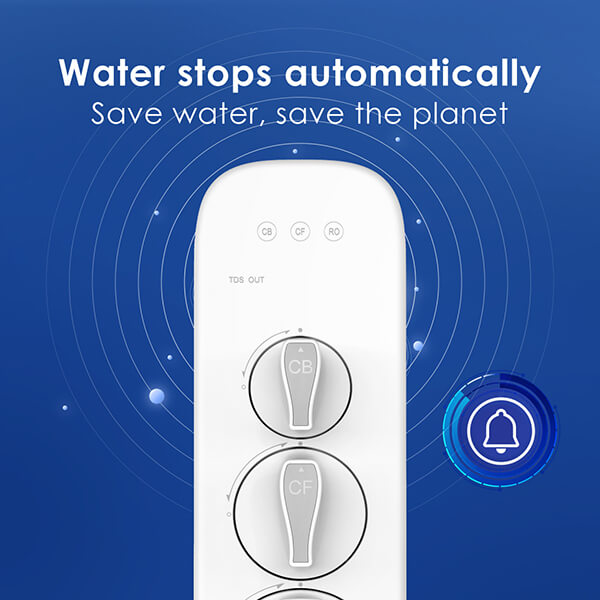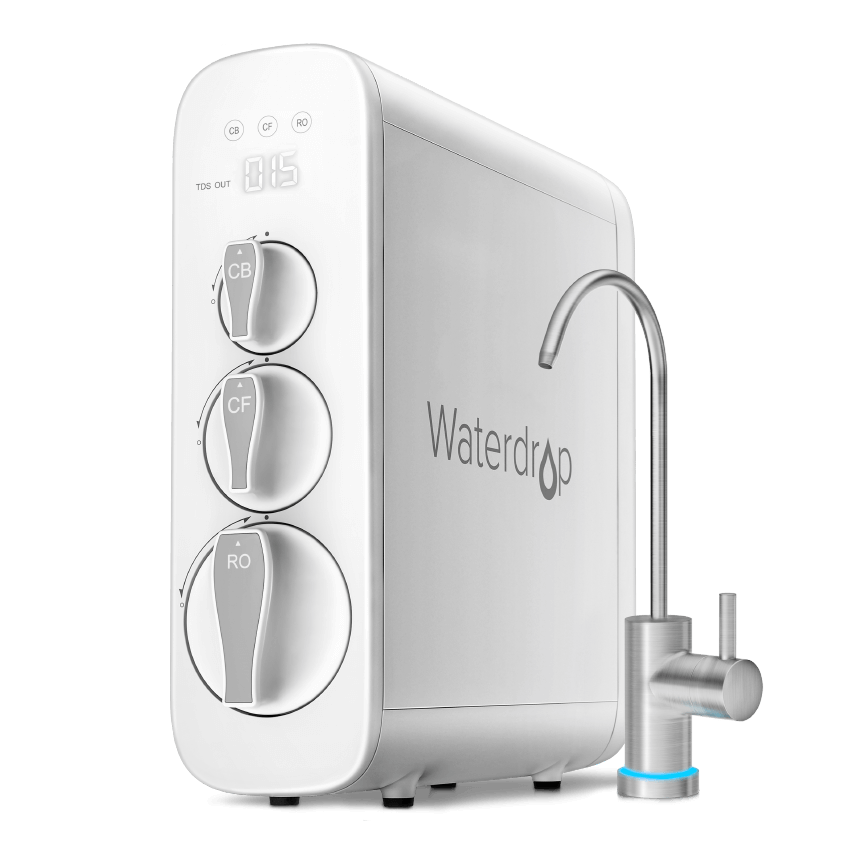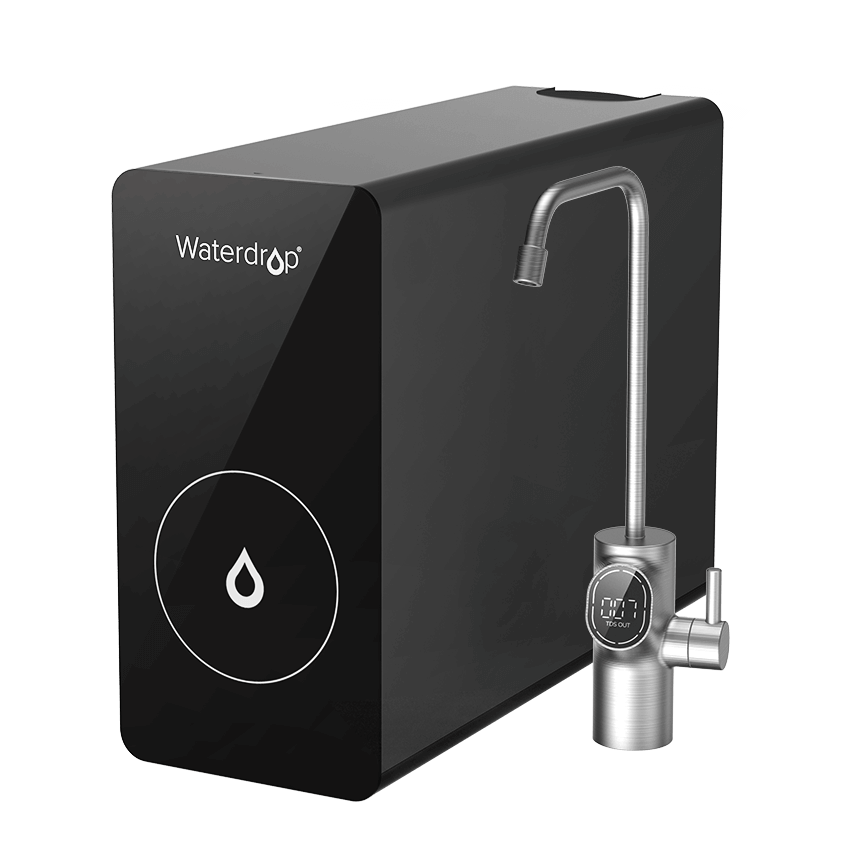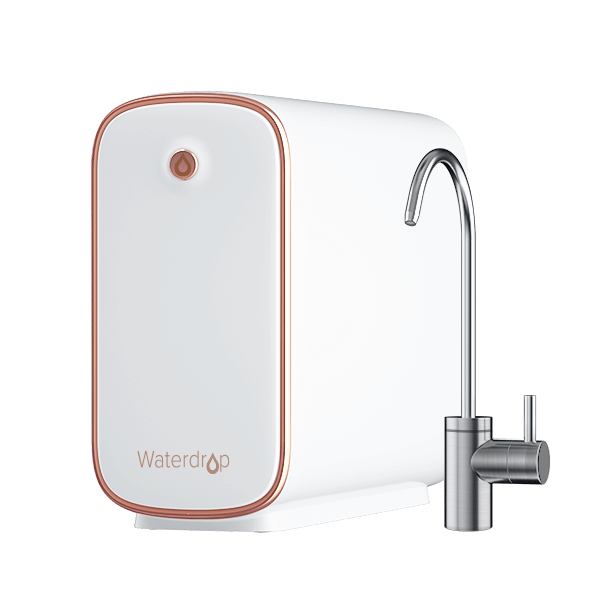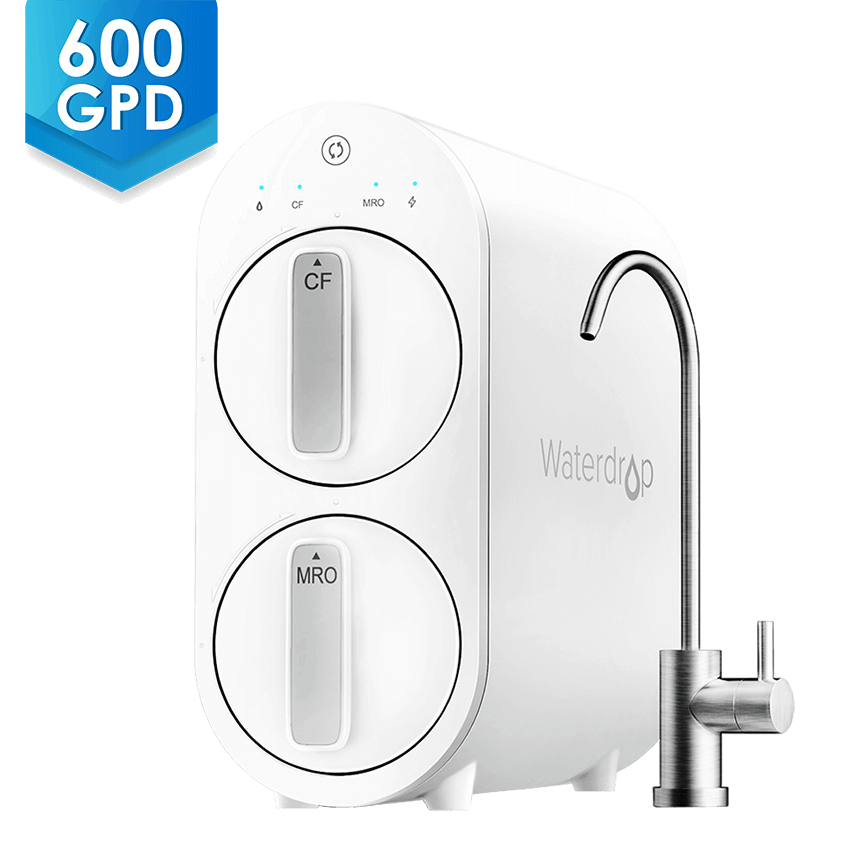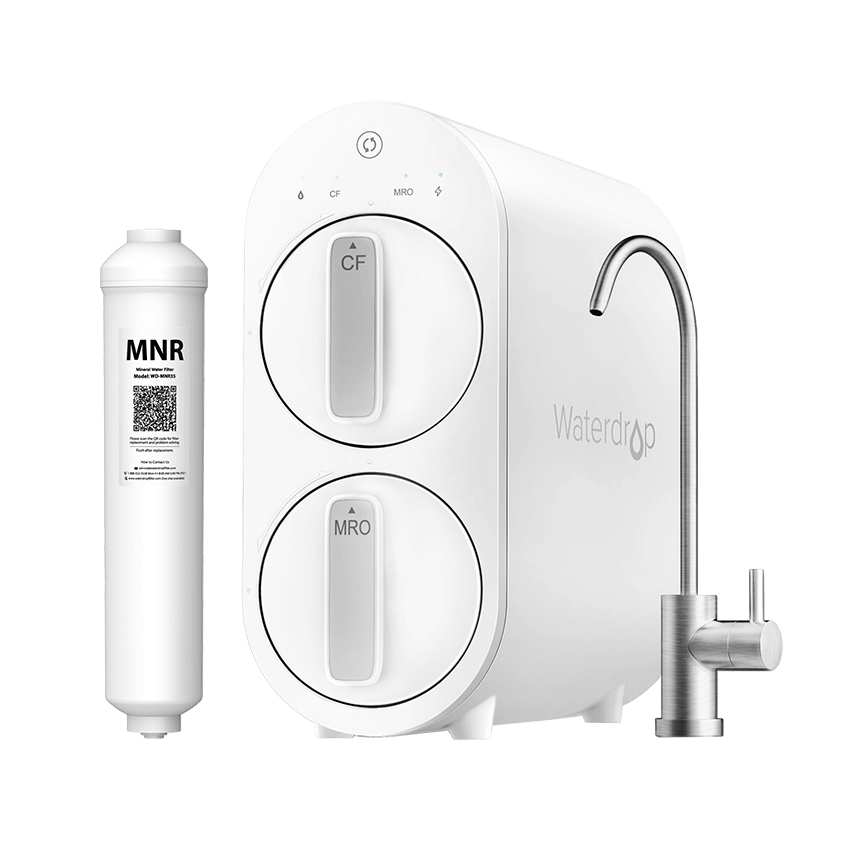What is the difference between Waterdrop and traditional RO systems?
What is reverse osmosis water systems?
Reverse osmosis (RO) is a water purification process
that uses a partially permeable membrane to filter out impurities from drinking water. In reverse
osmosis, an applied pressure is used to overcome osmotic pressure, a colligative property that is driven
by chemical potential differences of the solvent, a thermodynamic parameter. The result is that the
solute is retained on the pressurized side of the membrane and the pure water is allowed to pass to the
other side. To be "selective", this membrane should not allow large molecules or ions through the pores,
but should allow filtered clean water to pass freely.
How does a reverse osmosis system work?
A reverse osmosis system reduces sediment and
chlorine from water with a prefilter before it forces water through a semipermeable membrane to reduce
dissolved solids. After water exits the RO membrane, it passes through a postfilter to filter the
drinking water before it enters a faucet.
Does the reverse osmosis water filtration system produce wastewater?
All RO systems will produce concentrated water to
discharge impurities. Compared to traditional RO water purifiers, Waterdrop RO system produces less
concentrated water and saves 300% more water. You can collect concentrated water to mop the floor, wash
your car, do laundry, etc.
What contaminants can Waterdrop reverse osmosis water filter system remove?
Waterdrop reverse osmosis water filter system adopts
advanced composite filter technology. Uses the characteristics of various filter materials skillfully
and combines them to achieve better filtration. The composite filter can intercept most harmful
contaminant.
• TDS, chlorine, taste and odor, chloramine, scale,
turbidity.
• Carcinogens: chromium (hexavalent), chromium
(trivalent), cadmium and cadmium compounds, ferric oxide.
• Heavy metals: lead, mercury, barium, copper,
radium 226/228, aluminum.
• Microorganic contaminants: cysts.
• Inorganic pollutants: arsenic and inorganic
arsenic compounds, fluoride.
• Organic pollutants: asbestos, benzene,
formaldehyde, trichloromethane, chlordane, PFOA & PFOS, etc.
Does Waterdrop reverse osmosis water filter system need power?
The RO system has a pump that will need power to
maintain a fast water flow rate.
How to install reverse osmosis system?
Waterdrop RO systems are designed for DIY
installation. You can install the system in 30 minutes. Simply refer to the instruction manual and
instructional videos, or contact us by email, phone, or live chat.
This video explains how to install
Waterdrop RO system.
How often do I need to change the RO filter?
G3: The CF filter has a 6-month lifetime; the CB
filter has a 1-year lifetime; the RO filter has a 2-year lifetime. Waterdrop G3 Reverse Osmosis System
has a smart faucet and filter life indicators that will remind you to replace the filter.
Does the reverse osmosis system make a loud sound?
The sound will not exceed 65 dB, which is a
comfortable level for everyday life (65 dB is tested under standard laboratory conditions, where the
feed water pressure is between 14.5 psi and 87 psi). A loud sound may be caused by the following:
a. The system is not positioned in a flat area. Make
sure the system is placed smoothly without shaking.
b. The system is placed against the cabinet. Do not
place the system against the cabinet. The system may vibrate when it works.
c. The water pressure is unstable. Check and confirm
the water pressure is between 14.5 psi and 87 psi. The sound will decrease when the water pressure
becomes stable.
When you change filters, do you need to turn the water off?
The water source and power supply are not required
to be cut off when the filters need to be replaced. The replacements can be directly screwed and
reinstalled. RO system can be normally used after resetting and the flushing process are finished.
Does the RO system remove coliform and other parasites?
Our RO system uses reverse osmosis filtration
technology with a filtration accuracy of 0.0001um, and the system can effectively reduce most
contaminants, including coliform and other parasites.
Does this system eliminate or remove Atrazine?
As a benefit of the RO membrane (filtration
accuracy: 0.0001μm), this system is able to reduce the atrazine from the source water. In addition, the
composite filters of G3 can also reduce chlorine, fluoride, heavy metals and provide you with fresh and
tasty water.
Does this RO water system remove arsenic?
As a benefit of the RO membrane (filtration
accuracy: 0.0001μm), this product is able to reduce the arsenic efficiently from the source water. The
membrane has microscopic pores that are specially sized to allow water molecules through, while trapping
larger inorganic molecules like lead, iron, chromium and arsenic.
Is this reverse osmosis water filter system unit suitable for well water?
We do not recommend using well water as source for
our RO systems.
The reasons are as follows:
1. Large
particles.
Compared to municipal tap water, the well water is rich of large
particles, which will clog the filters easily, and shorten their lifetime significantly.Please note that
the filters will still need to be replaced more frequently, even if you have added a pre-filtration
system.
2. Composition
The well water has very
complicated compostion, and some of them (apart from the large particles) can cause the filter or
internal valve to be clogged and prevent the RO system from normal performance.
3. Water pressure
The well water may not provide the
feed water pressure that the RO system requires (14.5 psi min.). Furthermore, the water pressure will be
even lower after passing through pre-filtration systems.
Do you need to have an electrical outlet under your sink for this work?
As a standard appliance, this product will need to
be plugged into one electrical outlet to function normally.
Does this RO system need a drain piping nearby for discharge?
Yes, this model does need a drainpipe nearby, for
discharging the waste water. For that, we provide an adjustable drain saddle to connect the RO's waste
water tubing to your drainpipe.
What is the amount of space required between the RO unit and the cabinet?
In order to avoid the vibration which can affect the
use experience, please ensure that there is an about 1-inch gap between the RO system and the cabinet.
The size of the RO Filtration system is 18.11 "* 5.67" * 17.72 ", without a storage tank. It's very thin
and takes up very little space.
Is the water line hose 1/4" or 3/8"?
Inlet tubing: 3/8", Outlet tubing (connect with RO
faucet): 1/4", Feed water adapter: compatible with 3/8" and 1/2" water line.
Can I buy the accessory kit so that I can hook up my fridge all at once?
Yes, the instruction manual explains how to connect
the Waterdrop to your fridge using parts purchased from a hardware store. The output from the Waterdrop
to the faucet is 1/4” tubing. If your fridge has a 1/4” input, all you need is a 1/4” quick-connect
T-adapter and the tubing that you’ll run to your refrigerator - you can find these online or at your
local hardware store. If your refrigerator is like mine, the input is 3/8”, so I had to add an
additional 1/4” to 3/8” adapter to the line leading from the T-adapter to the fridge. It doesn’t affect
the performance of the Waterdrop at all.
Is this reverse osmosis water system BPA free?
Please note that our RO system is BPA free.
Does this reduce or remove the salt in the water from my water softener?
Although with filtration accuracy of 0.0001 μm, this
model can reduce Calcium ion 90% of the salt from the water, the remaining salt added by the water
softener may still affect the water taste. Therefore, we don't recommend placing the RO system after a
salt-based water softener, since the taste will be affected.
What is the minimum water pressure to operate this unit?
The rated water inlet pressure of the machine is
14.5-87psi. It can work properly within this range.
What size hole would I need to drill to install the faucet in my sink?
It's recommended to drill a hole of 1". If there's a
reserved hole for the soap dispenser on your countertop, you could use that to install the RO faucet
directly. In addition, we have included a sticker in the package, which could be used as a reference
while drilling the hole.
How often do you need to replace the reverse osmosis filters?
The life of the filter element of our machine
depends on the two indexes of service time and pure water after filtration. As long as one of them
reaches the upper limit, it needs to be replaced. The first stage front compound filter element is
recommended to last for 6 months or to filter 550 gallons of pure water. The second stage RO element is
recommended to last 24 months or to filter 2200 gallons of pure water. The third stage rear carbon rod
filter is recommended to last 12 months or to filter 1,100 gallons of pure water. Due to the different
water quality and water consumption of each house, the actual replacement time of the filter element is
not consistent. The actual use situation shall prevail. When the filter element needs to be replaced,
the prompt light on the machine and the lamp ring of the faucet will prompt through the color change.
You can replace it according to the prompt, which is very convenient.
Is the pump noisy?
I wouldn't call it noisy at all, but you can hear it
working. It is a low, vibrating sound.
How often do you have to change the membrane?
The RO membrane filter needs to be changed every 24
months or 2200 gallons.
Can the system be connected to the refrigerator so the ice is filter as well?
Generally speaking, the RO system can be connected
to your refrigerator. After completing the registration online, you could choose the accessory kit,
which will help you connect the RO to your refrigerator/ice maker. Since different refrigerator/ice
maker has various requirement of water pressure, it's not possible for our RO system to provide them
all. Connection under mismatched circumstance may result in many problems, including but not limited to:
slow ice making, frequent start-stop issue, etc. Therefore, it's NOT recommended to connect the RO
system to your refrigerator/ice maker.
Does this reverse osmosis water system prevent bacteria from growing in the filter?
Please rest assured that the RO membrane (filtration
accuracy 0.0001 μm) can effectively reduce bacteria and virus whose diameter are greater than 0.0001 μm
from the source water.
What is the waste water to filtered water ratio?
The waste to filtered water ratio is 1:1, which is
much higher than the traditional RO systems.
Can I use our own faucet?
Truly sorry, the chrome faucet is the only option
available now.
You could use your own RO faucet with our product, but not
normal faucet for tap water.
There are a few things you may need to know before
purchasing one:
Firstly, our faucet is equipped with a filter life indicator,
which allows you to monitor the filters' life easily. If you decide not to use our original faucet, this
function will not be in effect.
Secondly, your RO faucet should be able to
connect with the outlet tubing of the system, which has a diameter of 1/4".
In
addition, it should have a "Quick-Connect Fitting",
please click here.
OR, it
should come with a set of accessory parts, which allows you to connect the faucet with the bare end of
our outlet tubing.
Please click here to see the
example for your reference.If the faucet does not meet one of these
requirements, you will need to acquire a corresponding adapter, in order to complete the connection with
the machine.
What does Pure to Drain Rate mean?
The reverse osmosis water filter relies on a
semi-permeable membrane to filter out impurities from drinking water. When the tap water is
compressed through the RO membrane, it produced pure water and waste water. The ratio of pure water
to waste water is called wastewater ratio. 1:1 wastewater ratio means 1 gallon water is wasted per 1
gallon purified, and 2:1 wastewater ratio means 1 gallon water is wasted per 2 gallon purified. The
higher the wastewater ratio is, the less waster water produced during the filtration process. During
the use of RO water filter, the actual ratio might be lower than the labeled, depending on many
factors such as water quality, pH, pressure and temperature.




















































































































































